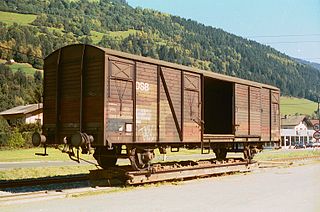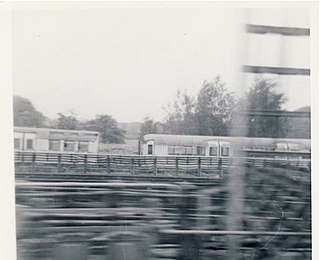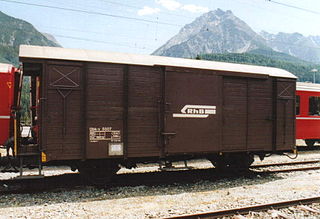
A train is a form of rail transport consisting of a series of connected vehicles that generally run along a railroad track to transport passengers or cargo. The word "train" comes from the Old French trahiner, derived from the Latin trahere meaning "to pull" or "to draw".

A railroad car, railcar, railway wagon, railway carriage, railway truck, railwagon, railcarriage or railtruck, also called a train car, train wagon, train carriage or train truck, is a vehicle used for the carrying of cargo or passengers on a rail transport system. Such cars, when coupled together and hauled by one or more locomotives, form a train. Alternatively, some passenger cars are self-propelled in which case they may be either single railcars or make up multiple units.

ISO 6346 is an international standard covering the coding, identification and marking of intermodal (shipping) containers used within containerized intermodal freight transport. The standard establishes a visual identification system for every container that includes a unique serial number, the owner, a country code, a size, type and equipment category as well as any operational marks. The standard is managed by the International Container Bureau (BIC).

A transporter wagon, in railway terminology, is a wagon (UIC) or railroad car (US) designed to carry other railway equipment. Normally, it is used to transport equipment of a different rail gauge. In most cases, a transporter wagon is a narrower gauge wagon for transporting a wider gauge equipment, allowing freight in a wider gauge wagons to reach destinations on the narrower gauge network without the expense and time of transshipment into a narrower gauge wagons.

London Underground 1935 Stock was an experimental train design by Metropolitan Cammell in London. Twelve two-car units were built.

Goods wagons or freight wagons, also known as goods carriages, goods trucks, freight carriages or freight trucks, are unpowered railway vehicles that are used for the transportation of cargo. A variety of wagon types are in use to handle different types of goods, but all goods wagons in a regional network typically have standardized couplers and other fittings, such as hoses for air brakes, allowing different wagon types to be assembled into trains. For tracking and identification purposes, goods wagons are generally assigned a unique identifier, typically a UIC wagon number, or in North America, a company reporting mark plus a company specific serial number.
The Victorian Railways used a variety of railway wagons for the transport of livestock.

Flat wagons, as classified by the International Union of Railways (UIC), are railway goods wagons that have a flat, usually full-length, deck and little or no superstructure. By contrast, open wagons have high side and end walls and covered goods wagons have a fixed roof and sides. Flat wagons are often designed for the transportation of goods that are not weather-sensitive. Some flat wagons are able to be covered completely by tarpaulins or hoods and are therefore suitable for the transport of weather-sensitive goods. Unlike a "goods wagon with opening roof", the loading area of a flat is entirely open and accessible once the cover is removed.

Wagon numbers are key data for railway operations. They enable a railway wagon or coach to be positively identified and form a common language between railway operators, infrastructure companies and the state authorities. The system of wagon numbering has been laid down by the International Union of Railways and is similar to that used for the locomotives and multiple units. Vehicle numbering is now governed by the Intergovernmental Organisation for International Carriage by Rail and in Technical Specifications for Interoperability (TSI) of the European Union.
The International Union of Railways groups all special classes of railway goods wagon into Class U in its goods wagon classification system.
The Victorian Railways used a variety of both 4-wheel and bogie open wagons for the transport of a wide range of loads.

The fleet of Great Western Railway wagons was both large and varied as it carried the wide variety of goods traffic on the Great Western Railway (GWR) in the United Kingdom. This was the railway company that operated for the longest period of time in the country and covered a large geographical area that included big cities such as London, industrialised areas including the West Midlands, areas of coal and mineral mining such as South Wales, and Somerset and other important agricultural districts. In 1902 the company owned 59,036 wagons, and by 1926 this had risen to 88,580.
Unlike the broad-gauge, the Victorian Railways' 2 ft 6 in narrow-gauge network never had four-wheeled trucks. Instead, a single design of 249 underframes was constructed, with identical structure, bogies, couplers and brake equipment. Different bodies were provided on these frames for each purpose. The most common, by far, was the convertible flat/open truck, followed by cattle, louvred, insulated and boxcar types.
The Victorian Railways in Australia have had a vast range of hopper-type wagons over the last century, for transporting anything from grains through fuel to various powders.

Buffers and chain couplers are the de facto UIC standard railway stock coupling used in the EU and UK, and on some surviving colonial railways, such as in South America and India on older coaches. These couplers are an assembly of several devices: buffers, hooks and links or screws.
The Victorian Railways used a variety of boxcars or covered goods wagons for the transport of all manner of goods. This page covers the history and development of the various classes, and how they changed through their lives.
The Victorian Railways used a variety of air-cooled and iced wagons or refrigerated vans for the transport of all manner of goods. This page covers the history and development of the various classes, and how they changed through their lives.
The Victorian Railways used a variety of air-cooled and iced wagons for the transport of all manner of goods. This page covers the history and development of the various classes, and how they changed through their lives.
The Victorian Railways used a variety of flat wagons for the transport of a wide range of loads. Generally speaking, the bogie wagons were custom-built for the job, while the fixed-wheel variants were cut down from former open wagons. Loadings would be placed on the deck and, if necessary, protected with tarps, then secured to the wagons with chains or rope connecting to lashing rings along the side of the wagon frames.
The Victorian Railways used a variety of former traffic wagons around depots and for specific construction, maintenance and similar tasks. Very few of these vehicles were specially constructed from scratch, often instead recycling components or whole wagon bodies and frames from old vehicles that had been withdrawn from normal service as life-expired or superseded by a better design.









